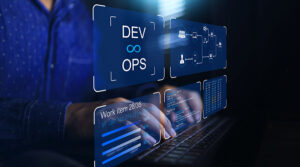Although many organizations have embraced the DevOps methodology, security concerns remain. Hackers and cybercriminals are a constant (and growing) threat to every aspect of the digital world, threatening everyone from major corporations to individual consumers. Fortunately, there’s the concept of DevSecOps for DevOps.
This article answers the question, “What is DevSecOps?” and explains how it works, its importance, best practices, tools, and how it differs from “plain” DevOps. It also shares an online DevOps program professionals can take to gain practical skills and knowledge about this critical process.
Let’s get things started with some definitions.
What is DevSecOps?
So, what is DevSecOps? Well, most people already know that DevOps is a software development methodology that merges development and operations, allowing the developers and IT teams to work together to build, test, and release software on time. The “sec” in DevSecOps stands for “security.” But what of it?
It is the process of introducing security measures early in the SDLC (software development life cycle). It also amplifies collaboration between developers and IT staff, allowing cybersecurity teams to work in the SDLC.
Thus, DevSecOps stands for Development, Security, and Operations, applying security into the CI/CD (continuous integration/continuous delivery) pipeline.
Also Read: DevOps Metrics: Measuring DevOps Success
How Does DevSecOps Work?
DevSecOps introduces security measures into each stage of the CI/CD pipeline. Although there are many different definitions and breakdowns of the CI/CD stages, depending on where you get your information, we’ll use the following CI/CD configuration to show how security fits in.
- Coding. This involves coding in segments that are trusted and secure.
- Building. The building stage requires run-time dependency scans that boost security. At the same time, the developers deliver comprehensive container images that include a core operating system, application dependencies, and additional run-time services.
- Storage. Every off-the-shelf application and back-end service must be continuously checked and scanned for vulnerabilities.
- Preparation. Teams must validate configurations against the organization’s security policies before deployment.
- Deployment. If the team has been following DevSecOps processes in the past steps, they should now better understand the application’s security effectiveness. Before deployment, the team should address all the vulnerabilities and remedy all security issues.
- Running. After deployment, security teams should leverage active deployment analytics, automation, and monitoring to ensure continuous security compliance while reducing the risk of any vulnerabilities surfacing after deployment.
Why is DevSecOps Important?
DevSecOps is a vital part of today’s IT landscape because it inserts security measures earlier in the SDLC and does so deliberately. When organizations code with security at the forefront, it’s easier and more cost-effective to spot and fix issues before they manifest themselves later in the design process or after release. Organizations in many different industries can implement it to eliminate the silos between development, security, and operations, enabling them to release more secure software faster. Here’s how DevSecOps plays a vital role in different industries.
- Automotive. DevSecOps decreases lengthy cycle times while ensuring organizations meet software compliance standards such as MISRA and AUTOSAR.
- Consumer, embedded, networked, and IoT devices. DevSecOps lets developers create secure code that minimizes the occurrence of today’s most dangerous software errors.
- Finance, retail, and e-commerce. DevSecOps ensures that today’s top application security risks are addressed while maintaining PCI DSS data privacy and security compliance during transactions with consumers, financial services, retailers, etc.
- Government. Cyber-criminals constantly target applications that manage highly sensitive government information. By fortifying these applications with a security-first application development approach, the risk of malicious parties finding and exploiting vulnerabilities is dramatically lessened.
- Healthcare. DevSecOps facilitates digital transformation progress while maintaining the patients’ data privacy and security as dictated by regulations such as HIPAA.
What Are the Benefits of DevSecOps?
DevSecOps has a lot to offer application development and design, including:
- Increased security. It helps prevent security vulnerabilities from getting insinuated into production systems.
- Diminished risk. It reduces the risks of security and data breaches.
- Better compliance. Automated processes help enforce compliance with established security regulations.
- Greater efficiency. It automates security checks and scans, improving the efficiency of the software development process.
- Improved compliance. It helps organizations comply with security regulations.
- Enhanced collaboration. It improves collaboration between the development, operations, and security teams via a shared sense of responsibility.
- Faster time to market. It uses automated scans and security checks to speed up the software development process.
- Improved quality. It improves software quality by spotting security vulnerabilities earlier in the development process.
- Better risk management. It helps organizations effectively identify and address security risks.
- Increased customer satisfaction. It can increase customer satisfaction by delivering more secure and reliable applications.
- Lower costs. It reduces costs typically associated with data breaches and other security issues.
- Improved visibility. It helps organizations gain better visibility into their security posture, allowing them to quickly identify and address security risks.
As good as these benefits are, implementing DevSecOps can be tricky, as we are about to see.
Also Read: A Comprehensive List of Top DevOps Tools for 2024
Challenges of DevSecOps Implementation
If you want to implement DevSecOps in your organization, you may need to change the organization’s culture and the staff’s mindsets. DevOps teams may have to be retrained to better comprehend the organization’s security best practices and familiarize themselves with new security tools. The team must understand that they are now responsible for software security as much as they are for the product’s function, features, and usability.
Finding the security tools most suitable for your organization and then integrating them into the DevOps workflow can be challenging. However, the more automated the tooling and the more it’s integrated into the CI/CD pipeline, the less training and cultural changes are needed.
However, many of today’s cloud-native applications run in containers that quickly spin down or up, challenging traditional security tools to perform risk analysis on container-based apps.
What Are DevSecOps Best Practices
Here’s a list of the best practices and characteristics of DevSecOps.
Automated Security Testing
Automated security testing is the foundation for a successful DevSecOps effort. Regular security scans (e.g., penetration testing, vulnerability assessments, and security code reviews) should integrate seamlessly into your organization’s development pipeline. Automated tools spot vulnerabilities and help teams prioritize the issues based on severity, allowing development teams to quickly address the most critical issues.
Collaboration and Training
DevSecOps flourishes from the collaboration between development, security, and operations teams. It’s the second-most important part of DevSecOps after automated security testing. Organizations should encourage a culture of information sharing and open communication while providing regular security awareness training to developers. This instruction helps the developers better understand the latest threats and mitigation techniques.
Continuous Monitoring and Feedback
DevSecOps emphasizes continuous, real-time monitoring of deployed applications, which helps identify and mitigate security threats in production. This process allows for immediate response and mitigation. DevSecOps teams should leverage APM tools and SIEM systems to acquire holistic insights into application behavior.
Infrastructure as Code (IaC) Security
As today’s infrastructures become more code-driven, the role of IaC security becomes increasingly vital. Applying security practices to infrastructure code helps maintain consistent security configurations and lowers the risk of misconfigurations that create security breaches. Teams should regularly audit and validate their infrastructure code to conform to security standards.
Immutable Infrastructure
Organizations should consider adopting immutable infrastructure practices. In these cases, deployed components are considered disposable entities. Detected vulnerabilities can be handled by replacing the whole component with an updated version, reducing the attack surface, and simplifying patch management.
Also Read: How to Enable Virtualization: A Guide for Aspiring DevOps Professionals
DevSecOps vs. DevOps
DevSecOps is more than just inserting “Sec” into DevOps. The two methodologies are quite different.
DevOps is a portmanteau for development and operations and focuses solely on collaborating between these two vital teams in software development. The two teams work together, developing processes, key performance indicators (KPIs), and milestones to target collaboratively so the operations team can more closely analyze the delivery stages while assessing the development team’s continual updates and feedback.
On the other hand, DevSecOps takes the DevOps model and adds security as an extra layer to the entire development and operations process. Rather than considering security an afterthought, it draws in application security teams early to strengthen and secure the development process from a security and vulnerability/risk mitigation perspective.
What Application Security Tools Are Typically Used in DevSecOps?
Here’s a sampling of application security tools (AST) typically used in DevSecOps.
- Aikido Security. Aikido Security consolidates various application scanning tools on a single platform, including open-source dependency scanning, cloud posture management, infrastructure as code scanning, secrets detection, static code analysis, and container scanning.
- Acunetix. Acunetix creates a comprehensive list of applications, websites, and APIs to ensure that no potential entry points are left unscanned and thus vulnerable to attack.
- Aqua Security. Aqua Security discovers and remediates malware, exposed secrets, vulnerabilities, and other risks in build tools, code, and delivery pipelines. It’s compatible with many environments, including CI/CD pipelines, containers, clouds, serverless platforms, registries, and DevOps tools.
- Checkmarx One. Checkmarx One offers a full suite of AST solutions, including API Security, Software Composition Analysis (SCA), Container Security, Static Application Security Testing (SAST), Supply Chain Security (SCS), Dynamic Application Security Testing (DAST), and Infrastructure as Code (IaC) Security.
- Codacy Quality. Codacy streamlines code review processes by monitoring and enforcing test coverage, code quality, and security standards, providing developers with actionable insights that fix potential security issues before they arise.
- Fortify by OpenText. Fortify provides comprehensive DevSecOps integrations, scalable application security, and flexible deployment options such as cloud-hosted solutions, managed services, and on-premises data centers.
- GitLab. GitLab is an AI-powered, comprehensive DevOps platform that boosts user efficiency throughout the SDLC, everything from planning to monitoring.
- Palo Alto Networks Prisma Cloud. This DevSecOps tool is a comprehensive Cloud Native Application Protection Platform (CNAPP) that offers extensive security and compliance coverage for applications, infrastructure, and workloads throughout the entire development lifecycle in hybrid and multi-cloud environments.
- Snyk. Snyk integrates directly into development tools, workflows, and automation pipelines, allowing teams to easily discover, prioritize, and fix any security weaknesses in code, containers, dependencies, and infrastructure as code.
- Veracode. This tool employs artificial intelligence to identify and rectify errors and vulnerabilities throughout the software development lifecycle. It integrates seamlessly into existing development toolchains and offers fast, accurate, and reliable results while barely interfering with the development process.
Do You Want to Learn About DevOps?
If you want to learn more about DevOps, consider this intense 36-week DevOps bootcamp. You will learn about popular DevOps tools like Ansible, Terraform, Docker, and Kubernetes through live, online classes, masterclasses led by industry experts, hands-on projects, and more.
Glassdoor.com reports that DevOps engineers earn an annual average of $112,130. If you’re looking for a career change or want to upskill in your current DevOps position, consider this highly effective course and be better prepared to tackle today’s DevOps challenges.
You might also like to read:
How to Build a Successful DevOps Career Path? [2024 Guide]
A Definitive DevOps Engineer Job Description
DevOps Engineer vs. Software Engineer: Key Differences and Similarities






